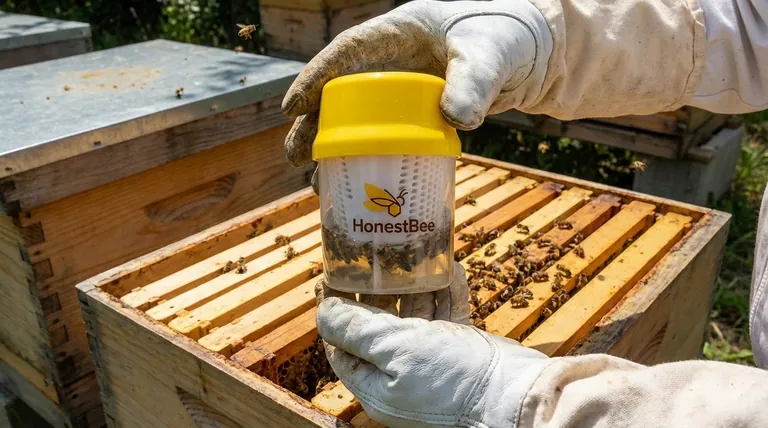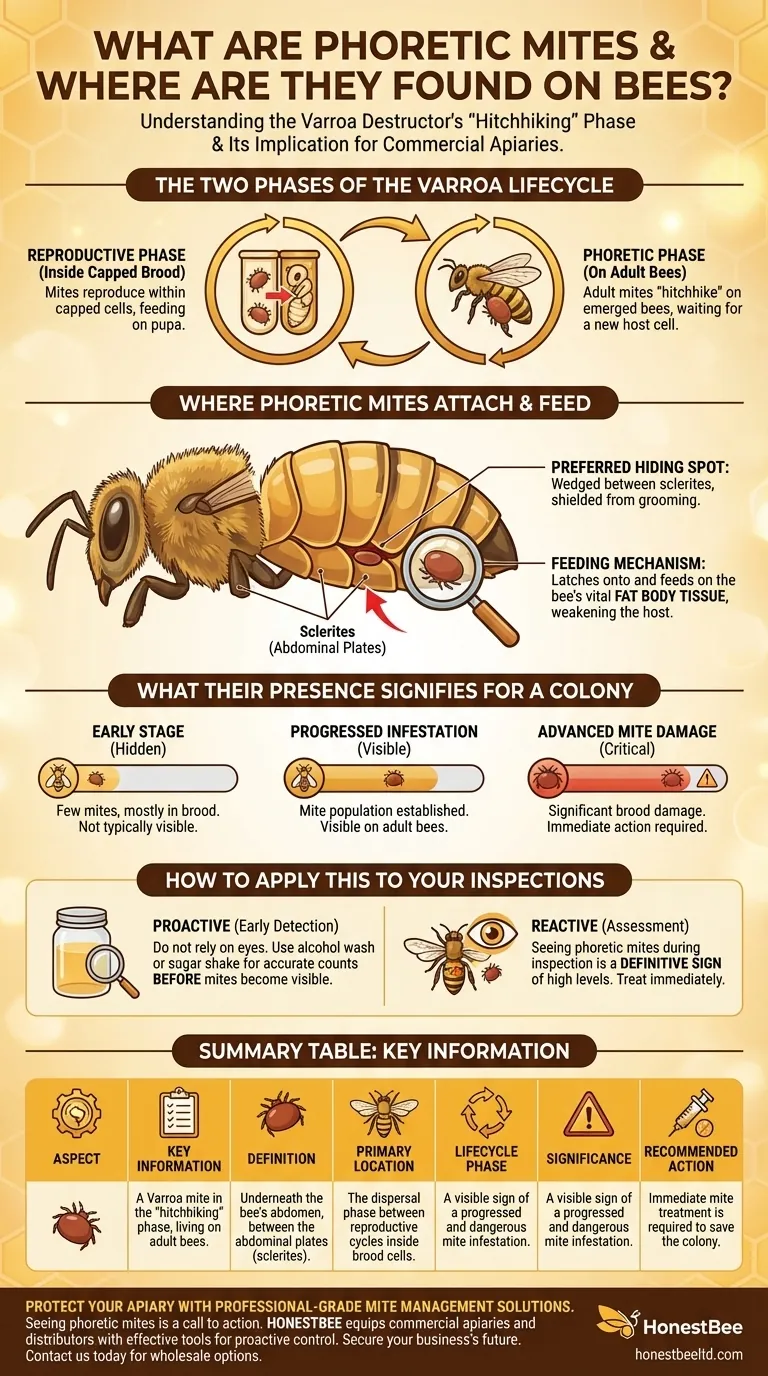In short, a phoretic mite is a Varroa mite in the "hitchhiking" phase of its life. These mites attach themselves to the outside of adult worker or drone bees, typically hiding underneath the bee's abdomen. They wedge themselves between the overlapping abdominal plates, known as sclerites, to securely latch on and feed.
The critical takeaway is that seeing phoretic mites on your bees is a clear visual indicator of a significant, and often dangerous, Varroa mite infestation that has progressed beyond its initial stages.

The Two Phases of the Varroa Lifecycle
To understand the role of the phoretic mite, it's essential to recognize the two distinct phases of the Varroa destructor's life. A mite population is constantly cycling between these two states within a honey bee colony.
The Reproductive Phase
The primary goal of a Varroa mite is to reproduce. This happens exclusively inside a capped honey bee brood cell. A female mite will enter a cell just before it is capped, lay her eggs, and they will hatch and mate within the sealed cell, feeding on the developing bee pupa.
The Phoretic Phase
When an adult bee emerges from its cell, any mature female mites and their mated daughters emerge with it. These mites are now in their phoretic phase, a term that means "to be carried" or "to hitchhike."
During this phase, the mites live on adult bees, feeding and waiting for an opportunity to enter another brood cell to begin a new reproductive cycle.
Where Phoretic Mites Attach and Feed
While you might occasionally spot a mite on a bee's back (thorax), this is not their preferred location. Their survival depends on being securely attached and protected.
The Preferred Hiding Spot
Most phoretic mites are found underneath the bee's abdomen. They specifically target the gaps between the sclerites—the overlapping hardened plates that make up the bee's exoskeleton.
The Latching and Feeding Mechanism
By tucking themselves between these plates, the mites are shielded from the bee's grooming attempts and from being accidentally brushed off. From this secure position, they latch on and feed on the bee's vital fat body tissue, weakening their host.
What Their Presence Signifies for a Colony
Observing phoretic mites on adult bees is more than a simple curiosity; it is a crucial diagnostic sign for the beekeeper. It tells you about the scale and maturity of your mite problem.
An Indicator of a Progressed Infestation
Visible mites on bees mean the infestation is no longer in its early, hidden stages. It suggests that the reproductive phase within the brood cells is well-established, and the mite population has grown large enough to be easily seen.
A Signal of Advanced Mite Damage
The presence of these mites places the colony in a more advanced stage of mite damage (often categorized as Stage 2 or higher). This level of infestation directly harms adult bees and, more importantly, signifies significant damage is occurring unseen within the brood.
How to Apply This to Your Inspections
Your approach to mite management should be directly informed by whether you can see phoretic mites.
- If your primary focus is early detection: Do not rely on visually spotting mites on bees. Most will be hidden, so proactive monitoring with an alcohol wash or sugar shake is necessary to find a problem before it escalates.
- If your primary focus is assessing a known issue: Seeing phoretic mites during a routine inspection is a definitive sign that your mite levels are high and immediate action is required to save the colony.
Proactive monitoring is always superior to discovering a mite problem only after it becomes visible.
Summary Table:
| Aspect | Key Information |
|---|---|
| Definition | A Varroa mite in the "hitchhiking" phase, living on adult bees. |
| Primary Location | Underneath the bee's abdomen, between the abdominal plates (sclerites). |
| Lifecycle Phase | The dispersal phase between reproductive cycles inside brood cells. |
| Significance | A visible sign of a progressed and dangerous mite infestation. |
| Recommended Action | Immediate mite treatment is required to save the colony. |
Protect Your Apiary with Professional-Grade Mite Management Solutions
Seeing phoretic mites is a clear call to action. Don't let a Varroa infestation decimate your hives and your profits. HONESTBEE equips commercial apiaries and beekeeping equipment distributors with the effective tools and knowledge needed for proactive mite control.
We understand the critical balance between hive health and operational efficiency. Our wholesale-focused operations provide reliable, high-quality supplies to help you manage mite levels before they become visible—and catastrophic.
Secure your colonies' health and your business's future. Contact our team today to discuss mite management strategies and wholesale supply options tailored to your commercial needs.
Visual Guide

Related Products
- Varroa Easy Check Mite Tester Kit Counter Alcohol Wash Jar
- Black Plastic Beetle Barn Hive Beetle Trap for Beehives
- Removable Washable Hive Beetle Trap Attractants for Small Hive Beetles
- Metal Queen Bee Excluder for Beekeeping
- Classic Wooden Bee Brush with Double-Row Boar Bristles
People Also Ask
- Why is an alcohol wash preferred over powdered sugar rolls? For Accurate Varroa Mite Management
- What is the Varroa EasyCheck and its purpose? Streamline Your Hive Health Monitoring
- How often should varroa mite checks be performed using the alcohol wash method? Optimize Your Apiary's Health
- How is the infestation percentage calculated after counting mites? Master Varroa Mite Monitoring
- What are some popular methods to measure Varroa mite load in beehives? Compare Accuracy & Bee Safety



















